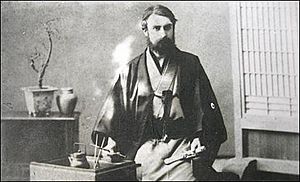W. K. Burton facts for kids
Quick facts for kids
William Kinnimond Burton
|
|
|---|---|

William Kinnimond Burton
|
|
| Born | 11 May 1856 |
| Died | 5 August 1899 (aged 43) |
| Citizenship | United Kingdom of Great Britain and Ireland |
| Scientific career | |
| Fields | Sanitary engineering |
William Kinnimond Burton (born May 11, 1856 – died August 5, 1899) was a talented Scottish engineer and photographer. He was born in Edinburgh, Scotland, but spent most of his working life in Meiji period Japan. He is famous for helping Japan build modern water and drainage systems.
Contents
A Life of Engineering and Photography
Early Life and Learning
William Burton was born in Edinburgh, Scotland. His father, John Hill Burton, was a writer and historian. His mother, Katherine, was the daughter of Cosmo Innes, a well-known early photographer.
William was also a childhood friend of Sir Arthur Conan Doyle, who wrote the Sherlock Holmes stories. Conan Doyle even asked Burton for ideas for one of his books, The Engineer's Thumb.
Instead of going to university, William started learning engineering in 1873. He did a five-year apprenticeship with Brown Brothers & Co. Ltd. This company built machines and hydraulic systems. He became their chief designer. Later, he worked with his uncle Cosmo Innes, designing water systems in London. In 1881, he joined the London Sanitary Protection Association.
Moving to Japan
In May 1887, the Japanese government invited Burton to come to Japan. They wanted him to be a professor of sanitary engineering at Tokyo Imperial University. At this time, Japan was facing serious health problems, like cholera outbreaks.
Burton's job was to teach and help Japan improve its public health. It was unusual because he didn't have a university degree. But he was very skilled and knowledgeable.
Building Modern Japan
For nine years, Burton trained many important water engineers in Japan. He became the main expert for the Sanitary Department of the Home Ministry. He planned and managed water and drainage systems for many cities, including Tokyo.
His work was the start of modern environmental and sanitary engineering in Japan. For example, the sand filtration system he built in Shimonoseki city is still used today! Water bottled there for emergencies even has his picture on the label.
Burton also designed Japan's first tall buildings, called skyscrapers. One was the Ryōunkaku in Tokyo. This 12-story building was 68.58 meters (about 225 feet) tall. It was the tallest building in Tokyo when it opened in 1890. It even had Japan's first electric lift. Sadly, it was badly damaged in the 1923 Great Kantō earthquake and had to be taken down.
Photography and Earthquakes
William Burton was also a famous photographer. He wrote several books about photography. He helped introduce Japanese culture to the West by sending his photos to magazines in London. He also helped new Japanese photographers show their work in Britain.
Burton worked with a scientist named John Milne. Together, they wrote and photographed a book about the terrible 1891 Mino–Owari earthquake. Their dramatic pictures showed how the earthquake affected people and the land.
Besides earthquakes, Burton photographed Japanese clothes and customs, Hakone, Mount Fuji, and everyday life. He worked closely with Japanese photographer Ogawa Kazumasa. They both helped start the Japan Photographic Society, which was Japan's first group for amateur photographers.
Later Work and Legacy
In 1896, after his time at Tokyo Imperial University, Burton went to Japanese Formosa (now Taiwan). He continued his work as an engineer, greatly improving sanitation systems in Taiwanese cities. He returned to Japan in 1899.
Burton married a Japanese woman named Orakawa Matsu in 1894. He had planned to visit Scotland with his family. However, he suddenly became sick with a liver infection and passed away on August 5, 1899, at the age of 43.
Awards and Memorials
William Burton's grave is in Aoyama Cemetery in Tokyo. His friends and former students built a large monument there to honor him.
In 2006, a memorial was also put up in his hometown of Edinburgh, Scotland. This was to celebrate 150 years since his birth. The memorial is at his family's old home, Craig House.
In 2018, he was added to the Scottish Engineering Hall of Fame. This honors the greatest engineers from Scotland.
Selected Works
- The ABC of Modern Photography (1884)
- Modern Photography (1887)
- The Process of Pure Photography (1889)
- The Great Earthquake of Japan (1891) (text by John Milne)
- The Volcanos of Japan, 1892 (text by John Milne)
- Practical Guide to Photography (1892)
- Outdoor Life in Japan (1893) (text by J Murdoch)
- Wrestlers and Wrestling in Japan (1895) (text by J Inoue)

